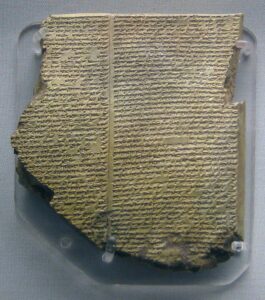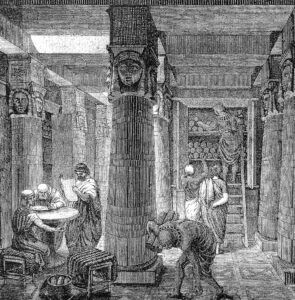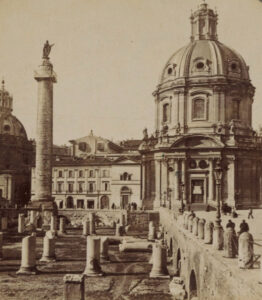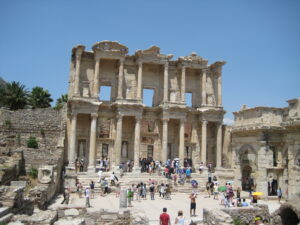By Dr. Don Bierle, FaithSearch President
Helen Bond, a professor of Christian Origins at the University of Edinburgh told The Daily Beast, “If Jesus was a carpenter/mason, as we generally suppose, then it’s not impossible that he had some rudimentary grasp of letters and/or numbers for the purposes of his trade, but I think it very unlikely that Jesus could read or write.”
Author Reza Aslan similarly told The Wall Street Journal, “…I would say the vast majority of biblical scholars would agree that the illiteracy rates in Jesus’s world were somewhere around 98 percent. 98 percent of Jesus’s fellow Jews could neither read nor write.”
Is this true…or naivety…or arrogance…or nonsense?
I will address the evidence of whether Jesus and His disciples could read or write in part 2 of this feature. Here, in part 1, I want to explore the literacy of the ancient world and reveal a problem for those who claim high illiteracy rates.
The problem: Why were there so many libraries in the ancient world if the illiteracy rate was about 98%?
Who wrote all the volumes in the many libraries of the day? Why build libraries at all in many cities if people couldn’t read the printed material that was in them? Let me give some examples.

(Public domain.)
Library of Ashurbanipal
The world’s oldest known library was founded centuries before Christ for the “royal contemplation” of the Assyrian ruler Ashurbanipal. Located in Nineveh, in modern-day Iraq, the site included a trove of some 30,000 cuneiform tablets organized according to subject matter. Most of its titles were archival documents, religious incantations, and scholarly texts, but it also housed several works of literature including the 4,000-year-old “Epic of Gilgamesh.”
The library was filled by looting works from Babylonia and the other territories Ashurbanipal conquered. This suggests that the reading, writing, and collection of books and documents was widespread.
Alexandrian Library
Following Alexander the Great’s death in 323 B.C., control of Egypt fell to his former general Ptolemy I Soter, who sought to establish a center of learning in the city of Alexandria. The result was the Library of Alexandria, which eventually became the intellectual jewel of the ancient world. At its peak, it may have included over 500,000 papyrus scrolls containing works of literature and texts on history, law, mathematics, and science. The library and its associated research institute attracted scholars from around the Mediterranean such as Strabo, Euclid, and Archimedes.
Pergamum Library
Constructed in the third century B.C. by members of the Attalid dynasty, the Library of Pergamum, located in what is now Turkey, was once home to a treasure trove of some 200,000 scrolls. It was housed in a temple complex devoted to Athena, the Greek goddess of wisdom. It eventually became so famous that it was in “keen competition” with the Library of Alexandria. Both sites developed rival schools of thought and criticism.
The Libraries of Trajan’s Forum
There were over two-dozen major libraries in the city of Rome during the imperial era, beginning with Caesar Augustus in 27 B.C. One of the most famous was Trajan’s Forum completed around 112 A.D. by Emperor Trajan. It was a sprawling, multi-use building complex which boasted plazas, markets, religious temples, and a library containing about 20,000 scrolls. The library was technically two separate structures—one for works in Latin, and one for works in Greek.
The Library of Celsus
Sometime around 120 A.D., the son of the Roman consul Tiberius Julius Celsus Polemaeanus completed a memorial library to his father in the city of Ephesus (in modern-day Turkey). The building’s ornate façade, restored with original stones in 1970-1978, still stands today. The original library featured four statues representing Wisdom, Virtue, Intelligence, and Knowledge. The library held about 12,000 scrolls and is considered an architectural marvel. Celsus was from Ephesus and was the governor of the province of Asia.
It is interesting that Ephesus, sixty years earlier, is the same place where the apostle Paul taught for three years:
And he entered the synagogue and continued speaking out boldly… But when some were becoming hardened… speaking evil of the Way before the multitude, he withdrew from them and took away the disciples, reasoning daily in the school of Tyrannus. And this took place for two years, so that all who lived in Asia heard the word of the Lord both Jews and Greeks.
Acts 19:8-10
Obviously, in that length of time there must have been more than just oral transmission of knowledge in their education.
This is the same context, thirty years before the library was built, in which the apostle John lived and taught. His teaching and that of the apostle Paul resulted in the founding of the seven Asian churches of Revelation 2-3, and more. When Paul sent the Prison Epistles to them later, he fully expected that his letters could be read and copied by them! (See Colossians 4:16.)
Conclusion
There were many more libraries than identified here. The facts seem to contradict the view of some scholars who hold that widespread literacy didn’t arise until the printing press was invented (not until the fifteenth century!). These critics state that it was just too expensive to create books, so these collections were limited to priests and scribes. Really? Hundreds of libraries existed in the ancient world containing hundreds of thousands of printed volumes – long before there was a printing press, even before Jesus came!
Interestingly, in the fifteenth century B.C., God said to Moses, “Write this on a scroll as something to be remembered…” (Exodus 17:14; see also Exodus 24:4; 34:27; Numbers 33:2). What about Jesus (see Luke 4:16; Matthew 22:31)? What about His disciples? I will gather the evidence for answers to these questions for part 2.
Sources: “World Wonders: Library of Celsus,” Biblical Archaeology Review, Spring 2024, p. 32. “Could Jesus Read and Write?”, Chris Keith, The Daily Beast, September 15, 2019. Gale General OneFile, link.gale.com/apps/doc/A609872040/ITOF?u=hennepin&sid=bookmark-ITOF&xid=f5b8fd63. Accessed May 16, 2024. “8 Legendary Ancient Libraries,” Evan Andrews, HISTORY Web site, by A&E Television Networks. Published November 17, 2016, updated August 22, 2023. Accessed May 16, 2024. https://www.history.com/news/8-impressive-ancient-libraries. “Was Jesus Illiterate? Author Reza Aslan Thinks So,” Christopher John Farley, The Wall Street Journal, August 1, 2013. Accessed May 16, 2024. https://www.wsj.com/articles/BL-SEB-76135#






